#Artemis I
Text

We love this image of Earth captured by the Orion capsule launched on Artemis I
#we are going#to#moon#space#earth#wonderful#photography#planet#artemis#artemis i#amazing#photo#satellite#galaxy#astronomy#astronaut#awesome#color#tumblr#nebula#solar system#nasa#national aeronautics and space administration#world#magic#god#creation
1K notes
·
View notes
Text
Artemis I liftoff
#sls#nasa#rocket#launch#space launch system#moon#Artemis 1#Artemis I#aerospace#engineering#srb#finally
978 notes
·
View notes
Photo
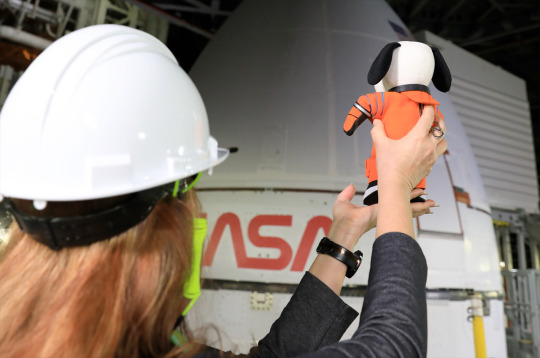


Snoopy is going to the Moon! 🚀🌕
The iconic canine character has been associated with NASA and the American space program since the late 1960s, when the Apollo mission adopted him as its safety mascot after a devastating fire aboard Apollo 1. In 1969, Charles Schulz drew a series of “Peanuts” comics featuring Snoopy, “the world-famous astronaut,” traveling to the moon. Now, Snoopy is on board the Orion spacecraft as a “zero gravity indicator” on its journey to test Orion’s technology in preparation for manned flights. He’s dressed in a specially designed miniature version of the pressure suits to be worn by future Artemis astronauts.
#this was too pure not to share#artemis i#snoopy#peanuts#nasa#as the planets turn and the old stars die and the young stars burn#we choose to go to the moon in this decade and do the other things
492 notes
·
View notes
Text
Managed to catch Artemis 1 from my backyard! It looked like the sun coming up! We could also see the booster separation, but unfortunately they didn’t show up on camera.



For comparison, here’s the Space X Crew-1 launch from November 15, 2020, shot in the same spot with the same phone:

The camera wouldn’t even focus on it. Tumblr won’t let me share more than one video at a time, but I was talking about “how bright” it looked. If only I knew then.
Best wishes to the whole Artemis team, you guys put on a great show!
480 notes
·
View notes
Text
The Adventures of Commander Moonikin Campos
Artemis I will be an enormous step toward humanity’s return to the Moon. This mission will be the first flight test of the integrated Space Launch System rocket and the Orion spacecraft — the same system that will send future Artemis astronauts to the Moon. That’s why NASA needs someone capable to test the vehicle. Someone with the necessary experience. Someone with the Right Stuff. (Or... stuffing).

Meet Commander Moonikin Campos. He is a manikin, or a replica human body. Campos is named after Arturo Campos, a trailblazing NASA employee who worked on Apollo missions. Arturo Campos’ skill as an electrical engineer was pivotal in the rescue efforts to help guide the Apollo 13 astronauts home.
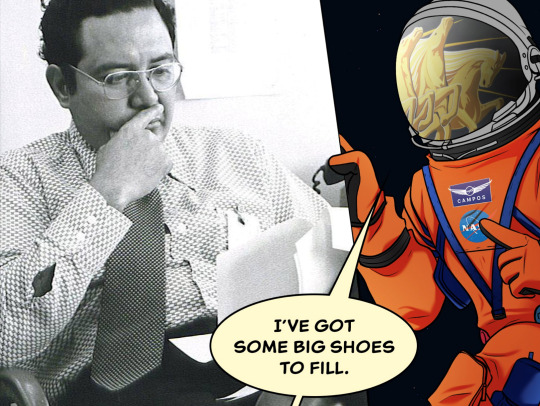
As the leader of the mission, Commander Campos will be flying in the pilot’s seat for the length of the mission: a journey of 1.3 million miles (~2 million km) around the Moon and back to Earth. He's spent years training for this mission and he loves a challenge.
Campos will be equipped with two radiation sensors and will have additional sensors under his headrest and behind his seat to record acceleration and vibration data throughout the mission.

Traveling with Campos are his quirky companions, Zohar and Helga. They’re part of a special experiment to measure radiation outside of the protective bubble of Earth’s atmosphere. Together with their commander, they’re excited to play a role in humanity’s next great leap. (And hopefully they can last the entire flight without getting on each other's nerves.)

Will our brave explorers succeed on their mission and ensure the success of future Artemis operations? Can Commander Moonikin Campos live up to the legacy of his heroic namesake?? And did anyone remember to bring snacks??? Get the answers in this thrilling three-part series!

In the first part of Commander Moonikin Campos’ journey, our trailblazing hero prepares for liftoff from NASA’s spaceport at Kennedy Space Center in Florida, gets acquainted with the new hardware aboard the Orion spacecraft, and meets his crewmates: Helga and Zohar!

In the second part of the trio’s adventure, Campos, Helga, and Zohar blast out of the Earth’s atmosphere with nearly 8.8 million pounds (4 million kg) of thrust powering their ascent. Next stop: the Moon!

In the final chapter of the Artemis I mission, Campos and friends prepare for their return home, including the last and most dangerous part of their journey: reentering Earth’s atmosphere at a screeching 25,000 miles per hour (40,000 kph).
Make sure to follow us on Tumblr for your regular dose of space!
#NASA#Artemis I#Space Launch System#SLS#Orion#spacecraft#moonikin#space#STEM#mega moon rocket#artemis#apollo 13#apollo#moon
733 notes
·
View notes
Text
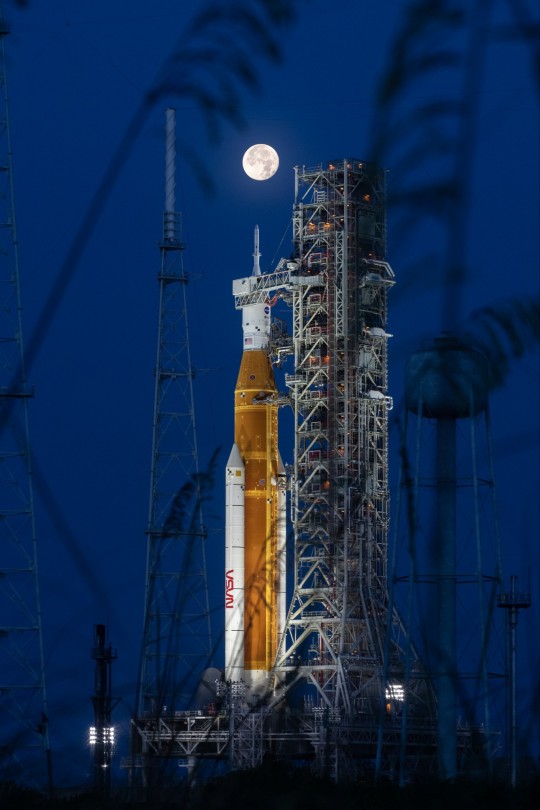
Artemis I SLS with Full Moon
"A full Moon is in view from Launch Complex 39B at NASA’s Kennedy Space Center in Florida on June 14, 2022. The Artemis I Space Launch System (SLS) and Orion spacecraft, atop the mobile launcher, are being prepared for a wet dress rehearsal to practice timelines and procedures for launch. The first in an increasingly complex series of missions, Artemis I will test SLS and Orion as an integrated system prior to crewed flights to the Moon. Through Artemis, NASA will land the first woman and first person of color on the lunar surface, paving the way for a long-term lunar presence and using the Moon as a steppingstone on the way to Mars."
Date: June 14, 2022
NASA ID: KSC-20220614-PH-CSH01_0068
83 notes
·
View notes
Text

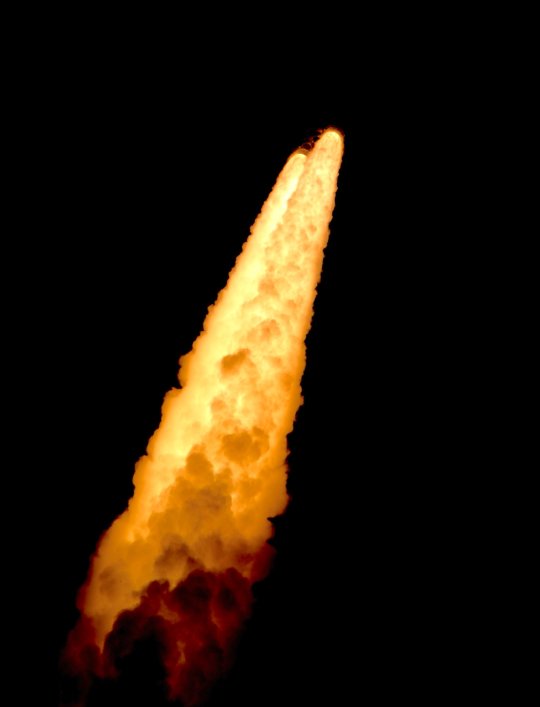
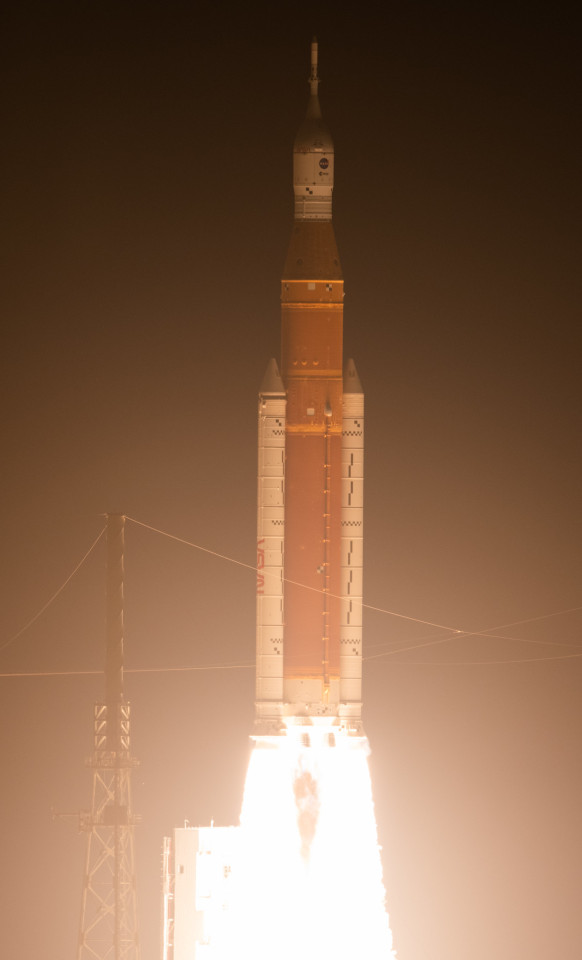
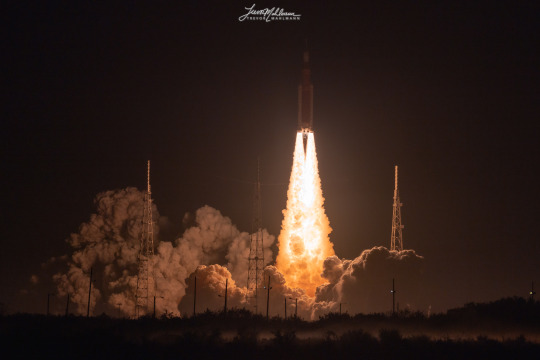
Credit: ESA photographer Stephane Corvaja, NASA HQ Photo and Trevor Mahlmann
#nasa#space#photography#artemis#artemis 1#artemis I#orion#orion spacecraft#moon#moon mission#science#launch#rocket#my post
220 notes
·
View notes
Text
Jeremy Hansen is heading to the moon.
The 47-year old Canadian astronaut was announced today as one of four astronauts — along with Christina Koch, Victor Glover and Reid Wiseman — who will be part of NASA's Artemis II mission.
"For me, it's a bit unreal still," Hansen told CBC's Paul Hunter.
[...]
Artemis I was the first test of NASA's new mega-rocket — the Space Launch System (SLS) and its new crew capsule, Orion. Uncrewed, it launched in November on a 25-day mission around the moon that was deemed a success.
Artemis II is the second step in NASA's mission to return astronauts to the surface of the moon.
Full article
Tagging: @politicsofcanada
#cdnpoli#canadian politics#canadian news#canadian#canada#uspoli#NASA#jeremy hansen#space#moon#astronauts#artemis I#artemis II#space exploration
80 notes
·
View notes
Text


The Moon rises above Artemis I
#I’m so emotional the mission is literally called Artemis#and the moon is just watching it all unfold#it’s so beautiful I wanna die#nasa#Artemis I#moon mission#orion spacecraft
90 notes
·
View notes
Text

The Orion spacecraft has plenty of cameras on it. Look at this beautiful image of the Earth, as it travels to the Moon. I am overjoyed to be alive for these historic missions. To the Moon now, To Mars in the future!
Also some more beautiful pictures of the launch because it was amazing



#nasa#nasa artemis#nasa sls#sls#artemis#sls orion#artemis orion#artemis 1#artemis i#space#moon#to the moon#back to the moon#we are going#quantumboogaloo
100 notes
·
View notes
Text

#girl help#im having feelings for a rocket#artemis i#WOOOOOOOOOOOOOOOO#MOON BASE IN MY LIFETIME#nasa#space#shitpost
70 notes
·
View notes
Text
HELLO TUMBLR
I WAS JUST BANNED OFF OF THE WEBSITE FORMERLY KNOWN AS TWITTER
I LOVE KERBAL SPACE PROGRAM AND I HOPE YOU ALL CAN APPRECIATE MY POST AND I CAN FIND A COMMUNITY HERE.
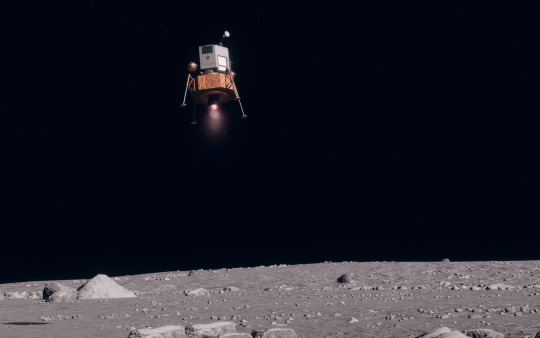
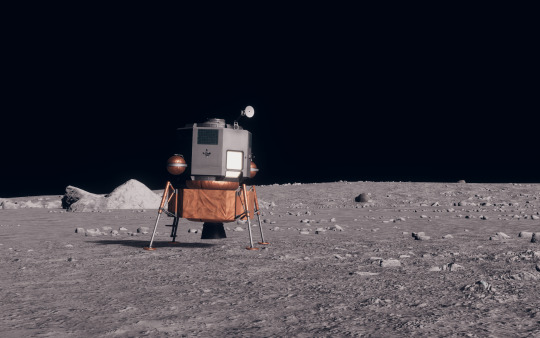


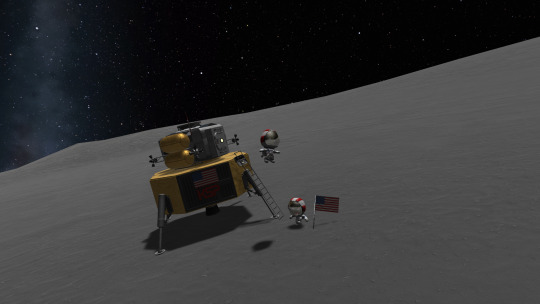
3 notes
·
View notes
Text
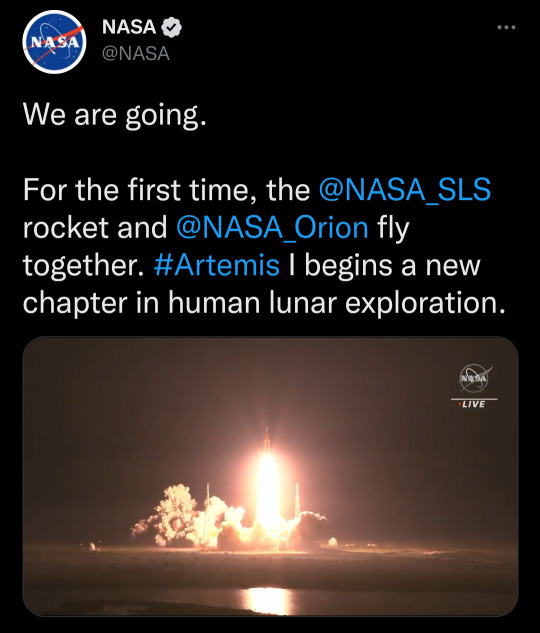

Now I know how the people who watched Apollo 11 blast off all those years ago must've felt. And it's wonderful! Seriously, I'm not even joking when I say I actually cried while watching the launch! So let's go, Artemis! And congratulations to everyone who worked on her!
32 notes
·
View notes
Text
Follow Orion Creatively During NASA’s Artemis I Mission

Trajectory data from the Orion spacecraft’s first mission around the Moon will be available to the public through NASA’s Artemis Real-time Orbit Website, also known as AROW. AROW, available on NASA’s website and on the @NASA_Orion Twitter account, allows almost anyone with internet access to track Orion’s flight as it happens.
Orion will travel to the Moon and 40,000 miles beyond on Artemis I, its first integrated flight test with the Space Launch System (SLS) rocket. Users can download trajectory data from the flight, called an ephemeris, from the AROW web page.
The ephemeris data can be used to track Orion with your own spaceflight software application or telescope. It can also be used to create a physics model, animation, visualization, tracking application, or other conceivable projects.
This data is generated by the Flight Dynamics Operations (FDO) group in the Mission Control Center at NASA’s Johnson Space Center in Houston. FDO is responsible for trajectory operations of Orion, keeping track of where the spacecraft is and where it is going to be. FDO uses tracking data from the Deep Space Network and predictive models to constantly update Orion’s predicted trajectory, so the Artemis flight control team has the best trajectory estimate possible. An accurate trajectory is essential for achieving mission objectives, maintaining communications links, lighting, adjusting the trajectory, and more.
Links at the bottom of the AROW web article will have the most current posted ephemeris. The ephemeris is in the Consultive Committee for Space Data Systems (CCSDS) Orbital Ephemeris Message (OEM) standard — a text file containing a header, metadata, explanatory information, and ephemeris data, available in the .txt file format.
After the OEM header, Orion state vectors — data describing exactly where Orion is located in space, and how it is moving — in the Mean of J2000 (J2K) reference frame are listed at four-minute intervals until entry interface at the end of mission. During trajectory maneuvers, the state vectors are reported in two-second intervals. Each state vector lists the time in Coordinated Universal Time (UTC); position X, Y, and Z in km; and velocity X, Y, and Z in km/s.
OEMs will be publicly available after Orion separates from the SLS rocket’s interim cryogenic propulsion stage that will give the spacecraft the big in-space push needed to fly beyond the Moon. Entry data will also be available for Orion’s return to Earth.
Follow @NASA_Orion on Twitter for AROW mission updates during Artemis I. Through Artemis missions, NASA will land the first woman and the first person of color on the surface of the Moon, paving the way for a long-term lunar presence and serving as a steppingstone on the way to Mars.
Track Orion during Artemis I at:
https://www.nasa.gov/specials/trackartemis/
View the latest ephemeris at:
https://www.nasa.gov/feature/track-nasa-s-artemis-i-mission-in-real-time
Erika Peters
NASA’s Johnson Space Center
63 notes
·
View notes
Text

Hopefully the final rollout
37 notes
·
View notes
Text

Artemis I, Crew-4, & Starlink Rockets on the Pad
"A SpaceX Falcon 9 rocket carrying a batch of the company's Starlink internet satellites lifts off from Launch Complex 40 at Cape Canaveral Space Force Station in Florida, on April 21, 2022. On the right, NASA’s Space Launch System rocket with the Orion spacecraft aboard sits atop a mobile launcher at Launch Complex 39B at Kennedy Space Center, while on the left at Kennedy’s Launch Complex 39A is a SpaceX Falcon 9 rocket with the company's Crew Dragon spacecraft, as preparations continue for the agency’s Crew-4 mission to the International Space Station."
Date: April 21, 2022
NASA ID: KSC-20220421-PH-KLS01_0054
#Artemis 1#Artemis I#Orion CM-002#Orion Multi-Purpose Crew Vehicle#Orion MPCV#Orion#Artemis program#NASA#LC-39B#SpaceX Falcon 9#Crew 4#Falcon 9#SpaceX#launch#Kennedy Space Center#KSC#LC-40#April#2022#my post
15 notes
·
View notes